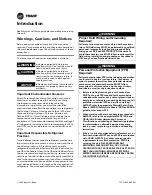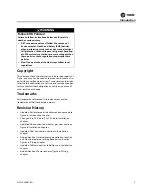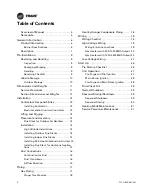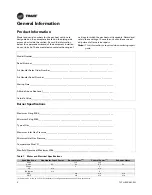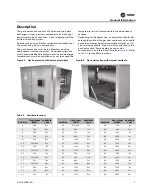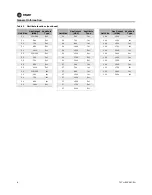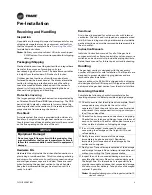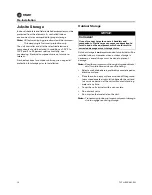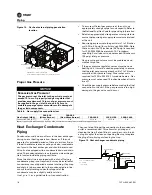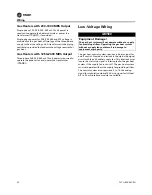
CLCH-SVX08C-EN
9
Pre-Installation
Receiving and Handling
Inspection
Upon delivery, thoroughly inspect all components for any
shipping damage that may have occurred, and confirm
that the shipment is complete. See
for detailed instructions.
Note:
Delivery cannot be refused. All units are shipped
F.O.B. factory. Trane is not responsible for shipping
damage.
Packaging/Shipping
Gas heat sections arrive at the jobsite with an integral base
frame for the purpose of mounting units to a
housekeeping pad or roof curb. The base frame variables
in height from the standard 2.5 inches to 8 inches.
Outdoor gas heat sections ship with wooden blocks
fastened under the base channel. The blocks elevate the
section for shipping protection and ease of handling.
Leave the wooden blocks attached until the section is
placed in its final position to avoid bending the base
channel during rigging and handling.
Protective Covering
The large openings of the gas heat section are protected by
an Oriented Strand Board (OSB) panel covering. The OSB
panel is held in place by sheet metal screws. Leave the
covering attached to the section until it is ready to install to
prevent debris from entering the section.
Flue Stack
A stainless-steel flue stack is provided with outdoor air
handlers. It ships inside the gas heat section or in one of
the other sections of the air handler, and must be mounted
on the flue opening on the side of the unit.
Hardware Kits
Hardware kids ship inside the air handler fan section in a
plastic bag or cardboard box. This kit contains gasketing
and screws. For outdoor units, roof joint connection strips
and wall panel seam caps are included. These are used
when fastening the gas heat section to the air handler.
Keep the hardware with the gas heat section until it is
ready to install.
Rain Hood
A rain hood is provided for outdoor units with internal
vestibules. The rain hood is shipped on a separate wood
skid. A kit containing mounting hardware ships inside the
gas heat section and must be removed before assembly to
the air handler.
Instruction Manuals
Individual instruction manuals for all of the gas train
components (such as flame-control relay valves, pressure
switches, and actuators) ship inside the piping vestibule.
Retain these manual for future repair or troubleshooting.
Handling
The gas heat section is designed with the necessary
number of lift points for safe installation. The lift points are
designed to accept standard rigging devices and are
removable after installation.
Indoor sections size 3-30 will be shipped with a shipping
skid designed for forklift transport. If shipped on a skid, do
not remove the gas heat section from the skid at this time.
Receiving Checklist
Complete the following checklist immediately after
receiving shipment to detect possible shipping damage.
NOTICE
Equipment Damage!
Do not use type B flue stacks with this product as they
are not suitable for the flue gas temperatures. Failure to
follow this recommendation could result in equipment
damage.
Check to ensure that the shipment is complete. Small
components may ship inside the unit or ship
separately. Check the parts list to ensure all materials
are present. If any component is missing, contact your
local Trane sales office.
Check all units, components, connections, and piping.
Check all doors, latches and hinges. Inspect interior of
each unit or section. Check for rattles, bent corners, or
other visible indications of shipping damage.
If a unit is damaged, make specific notations
concerning the damage on the freight bill. Do not
refuse delivery.
Notify the carrier’s terminal of the damage
immediately by phone and mail. Request an
immediate joint inspection of the damage by the
carrier and consignee.
Notify your Trane sales representative of the damage
and arrange for repair. Do not attempt to repair the unit
without consulting the Trane representative.
Inspect the unit for concealed damage as soon as
possible after delivery. Report concealed damage to
the freight line. It is the receiver’s responsibility to
provide reasonable evidence that concealed damage
did not occur after delivery. Take photos of damaged
material if possible.
Note:
Concealed damage must be reported within 15
days of receipt.


